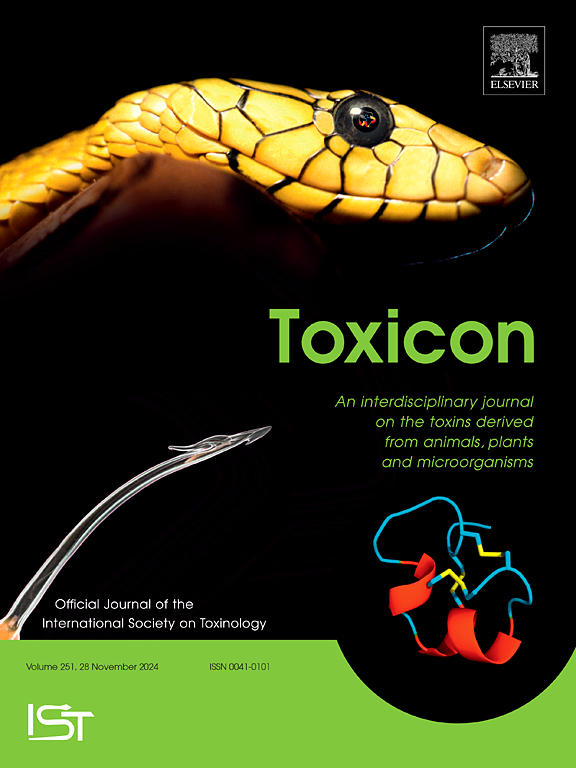兔用石线虫毒液和二氧化硅纳米粒子组成的纳米毒液免疫:第一个体内方法
IF 2.6
4区 医学
Q2 PHARMACOLOGY & PHARMACY
引用次数: 0
摘要
由于其高含量的强效神经毒素造成严重的神经毒性中毒。这些毒素的免疫原性差是抗蛇毒血清(AV)产生的一个重大挑战。二氧化硅纳米颗粒(SiNPs)由于其刺激免疫系统的能力而被提出用于医学。本研究探讨了将SiNPs作为佐剂(ADJ)与蛇毒(nanovenoms, NV)混合用于兔免疫的可能性,并与传统的Freund ADJ乳化毒液和单独使用毒液进行了比较。ELISA结果显示,NV免疫兔血清产生的抗体应答与Freund佐剂免疫兔血清相似,且注射部位未出现明显病变。Western blot分析表明,NV血清组对神经毒素有较强的识别能力,能中和一定剂量(1.5 LD50)的毒,延长了小鼠的存活时间。结果表明,NV是一种较好的抗疫抗体,可用于工业生产。本文章由计算机程序翻译,如有差异,请以英文原文为准。
Immunization of rabbits with nanovenom composed of Dendroaspis polylepis venom and silica nanoparticles: a first in vivo approach
Dendroaspis polylepis inflicts severe neurotoxic envenomings due to its high content of potent neurotoxins. The poor immunogenicity of these toxins represents a significant challenge in antivenom (AV) generation. Silica nanoparticles (SiNPs) have been proposed for use in medicine due to their ability to stimulate the immune system. This study explored the possible use of SiNPs as adjuvant (ADJ) mixed with D. polylepis venom (nanovenoms, NV) for immunization in rabbits, compared to venom emulsified with the traditional Freund ADJ and with venom alone. ELISA results show that sera from rabbits immunized with NV developed an antibody response similar to sera from rabbits immunized with Freund adjuvant, and did not develop significant lesions at the injection site. Western blot analysis indicates that NV sera group showed a strong recognition of neurotoxins and neutralized a challenge dose of venom (1.5 LD50), increasing the survival time of mice. In conclusion, NV proved to be a good ADJ in immunization with D. polylepis venom and could be tested for AV industrial production.
求助全文
通过发布文献求助,成功后即可免费获取论文全文。
去求助
来源期刊

Toxicon
医学-毒理学
CiteScore
4.80
自引率
10.70%
发文量
358
审稿时长
68 days
期刊介绍:
Toxicon has an open access mirror Toxicon: X, sharing the same aims and scope, editorial team, submission system and rigorous peer review. An introductory offer Toxicon: X - full waiver of the Open Access fee.
Toxicon''s "aims and scope" are to publish:
-articles containing the results of original research on problems related to toxins derived from animals, plants and microorganisms
-papers on novel findings related to the chemical, pharmacological, toxicological, and immunological properties of natural toxins
-molecular biological studies of toxins and other genes from poisonous and venomous organisms that advance understanding of the role or function of toxins
-clinical observations on poisoning and envenoming where a new therapeutic principle has been proposed or a decidedly superior clinical result has been obtained.
-material on the use of toxins as tools in studying biological processes and material on subjects related to venom and antivenom problems.
-articles on the translational application of toxins, for example as drugs and insecticides
-epidemiological studies on envenoming or poisoning, so long as they highlight a previously unrecognised medical problem or provide insight into the prevention or medical treatment of envenoming or poisoning. Retrospective surveys of hospital records, especially those lacking species identification, will not be considered for publication. Properly designed prospective community-based surveys are strongly encouraged.
-articles describing well-known activities of venoms, such as antibacterial, anticancer, and analgesic activities of arachnid venoms, without any attempt to define the mechanism of action or purify the active component, will not be considered for publication in Toxicon.
-review articles on problems related to toxinology.
To encourage the exchange of ideas, sections of the journal may be devoted to Short Communications, Letters to the Editor and activities of the affiliated societies.
 求助内容:
求助内容: 应助结果提醒方式:
应助结果提醒方式:


